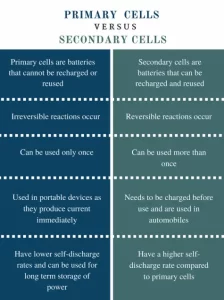Primary and secondary batteries play crucial roles in energy storage, each offering distinct advantages and limitations. Understanding the disparity between these two types of batteries is essential for informed decision-making in various applications. This article delves into the disparities between primary and secondary batteries, elucidating their functionalities and implications for practical use.
Part 1. Primary battery
A primary battery, also known as a disposable battery, is designed for single use, and users cannot recharge it. These batteries generate electrical energy through a chemical reaction that occurs within them.
It is commonly found in various everyday devices such as remote controls, flashlights, toys, and watches. Primary batteries come in different chemistries, including alkaline, zinc-carbon, and lithium. Each type has specific advantages and disadvantages, making them suitable for other applications. For example, alkaline batteries offer a long shelf life and high energy density. In contrast, zinc-carbon batteries are more affordable but have a shorter lifespan.
Part 2. Primary battery advantages and disadvantages
Advantages
- Convenience: Primary batteries are readily available in stores and online, making them convenient for immediate use.
- Long Shelf Life: They have a longer shelf life than rechargeable batteries, allowing for extended storage without significant loss of power.
- No Maintenance Required: Primary batteries do not require maintenance or monitoring, making them hassle-free for users.
- Initial Cost: Primary batteries are cheaper upfront than rechargeable batteries, making them cost-effective for single-use applications.
Disadvantages
- Single Use: Once depleted, primary batteries cannot be recharged and must be disposed of, contributing to environmental waste.
- Cost Over Time: While cheaper initially, continuously purchasing primary batteries for long-term use can add up compared to rechargeable batteries.
- Limited Lifespan: Primary batteries have a finite lifespan and will eventually lose their charge, requiring replacement.
- Environmental Impact: Improper disposal of primary batteries can lead to environmental pollution due to the presence of toxic materials such as mercury and lead.
Part 3. Secondary battery
A secondary battery, also known as a rechargeable battery, is a type of battery that users can recharge and reuse multiple times. Unlike primary batteries, designed for single use, secondary batteries utilize an external electrical current to reverse the chemical reaction during discharge, enabling users to renew them for multiple uses. This process restores the battery’s energy storage capacity, allowing the users to use it again. Secondary batteries power electronic devices such as smartphones, laptops, and electric vehicles, requiring frequent recharging to maintain functionality. They come in various chemistries, including lithium-ion, nickel-cadmium, and nickel-metal hydride, each with advantages and limitations.
Part 4. Secondary battery advantages and disadvantages
Advantages
- Reusability: Users can recharge and reuse secondary batteries multiple times, reducing the need for frequent battery replacements and saving money in the long run.
- Environmental Friendliness: Secondary batteries help minimize environmental waste and pollution by reducing the number of disposable batteries that people throw away.
- Cost Savings: Although secondary batteries may have a higher initial cost than primary batteries, users can achieve cost savings over time by recharging them multiple times.
- Versatility: Secondary batteries are available in various chemistries and sizes, making them suitable for multiple applications, from small electronic devices to large vehicles.
Disadvantages
- Limited Lifespan: Despite being rechargeable, secondary batteries have limited charge-discharge cycles before they degrade and lose capacity.
- Charging Time: Secondary batteries typically require longer charging times compared to the quick and easy replacement of primary batteries, which can be inconvenient for users with immediate power needs.
- Memory Effect: Some secondary batteries, such as nickel-cadmium batteries, are susceptible to memory effect, where the battery gradually loses capacity if not fully discharged before recharging.
- Safety Concerns: Certain secondary battery chemistries, such as lithium-ion, can be prone to overheating and even catching fire or exploding if damaged or improperly handled, posing safety risks to users.
Part 5. What is the difference between a primary battery and a secondary battery?

Reusability
- Primary batteries are designed for single use only and cannot be recharged.
- Secondary batteries, on the other hand, can be recharged and reused multiple times.
Chemical Reaction
- Primary batteries generate electrical energy through a one-time chemical reaction.
- Secondary batteries undergo reversible chemical reactions, enabling users to recharge using an external power source.
Longevity
- Primary batteries typically have a longer shelf life and can be stored for extended periods without significant power loss.
- Secondary batteries may have a shorter shelf life but can last longer overall due to rechargeability.
Cost
- Primary batteries are generally cheaper upfront but may become more expensive over time due to the need for frequent replacements.
- Secondary batteries have a higher initial cost but provide long-term cost savings as they can be reused multiple times.
Environmental Impact
- Primary batteries contribute to environmental waste by being disposed of after a single use.
- Secondary batteries contribute to environmental friendliness by allowing reuse and reducing the number of batteries thrown away.
Part 6. FAQs
-
What is the difference between a primary cell and a battery?
A primary cell refers to a single non-rechargeable electrochemical cell. At the same time, a battery consists of two or more cells connected in series or parallel to provide a higher voltage or capacity. -
What is the difference between a primary battery and a storage battery?
A primary battery is a non-rechargeable battery intended for single use. In contrast, a storage battery, also known as a secondary battery, is rechargeable and can be reused multiple times by recharging it after depletion. -
What are the advantages of secondary batteries over primary batteries?
Secondary batteries offer the advantage of rechargeability, allowing users to reuse them multiple times, which can be cost-effective and environmentally friendly compared to single-use primary batteries. -
What are the advantages of primary batteries over secondary batteries?
Primary batteries are convenient and straightforward, as they do not require recharging and can be used immediately out of the package without additional charging equipment. -
Do primary or secondary batteries last longer?
Secondary batteries typically last longer since users can recharge and reuse them multiple times. In contrast, primary batteries are designed for single use and have a limited lifespan.
Related Tags:
More Articles

Overview of Deep Cycle Lithium Battery
In this article, we explore the life, voltage, capacity, and charging considerations of deep cycle lithium batteries.
How Long do Lithium Batteries Last?
How long do lithium batteries last? we will explore the factors that influence the lifespan of lithium batteries and provide insights into their longevity.
How to Choose the Best LiFePO4 Battery?
Choose LiFePO4 batteries for superior performance, safety, and versatility in EVs, UPS, and backup power. This guide helps you make informed decisions.
Get 12v Lithium Car Battery As a Power Source for the Ride
Make the right choice for your vehicle's battery needs by installing a 12 volt lithium car battery. You will enjoy maintenance-free longevity with this change.
Everything About A Small Lithium Ion Battery
Discover the features, uses & future potential of a small lithium ion battery. A compact and tiny powerhouse ideal for smartphones, wearables, drones & more.



